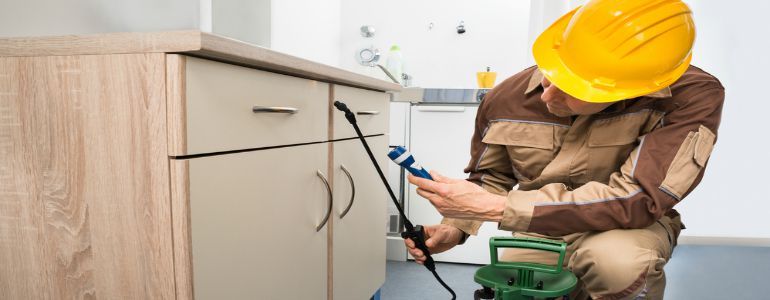Relied on Exterminator Near Me: Your Neighborhood Pest Control Remedy!
Relied on Exterminator Near Me: Your Neighborhood Pest Control Remedy!
Blog Article
Professional Pest Control Techniques for Long-Term Outcomes
Specialist insect control strategies encapsulate an extensive method that begins with an extensive examination and assessment, followed by specific pest identification to comprehend their actions patterns. The implementation of Integrated Insect Monitoring (IPM) principles, coupled with eco-conscious treatments, creates the keystone of lasting parasite eradication.
Examination and Analysis
Upon getting in a residential property for parasite control solutions, the preliminary step is a complete assessment and evaluation to determine the degree of the invasion and identify the most effective treatment strategy. Specialist parasite control technicians are educated to diligently check out the properties, trying to find indications of insect activity such as droppings, gnaw marks, nests, or any kind of architectural damage. They will additionally analyze the problems that may be drawing in insects, such as food resources, water leaks, or entry factors.

Parasite Identification and Habits

Moreover, recognizing the habits of the determined parasite is key to executing efficient control procedures. Knowing where insects nest, what they feed on, and their activity patterns can aid pest control professionals devise approaches to eliminate them effectively. Some pests might be nocturnal, while others are more energetic throughout the day. This understanding allows for the application of therapies at optimum times for optimum efficiency.
Integrated Parasite Administration (IPM)
Integrated Bug Management (IPM) methods combine numerous methods to control and protect against bug infestations in a lasting and eco-friendly way. Exterminator DC. By incorporating approaches such as biological control, habitat manipulation, adjustment of social practices, and using immune selections, IPM aims to lessen using chemical pesticides
One of the essential concepts of IPM is the focus on avoidance. This proactive method entails surveillance pest populations consistently to spot any kind of possible issues before they intensify. By recognizing parasite problems at an early stage, pest control procedures can be applied promptly and effectively.
Moreover, IPM advertises using safe pest control methods whenever possible. This can include utilizing all-natural killers of the insects, introducing valuable pests, or using pheromones to interrupt breeding patterns. By reducing reliance on chemical pesticides, IPM not only secures the setting but also helps maintain a balance in the community.
Environmentally-Friendly Therapies
Applying eco-conscious approaches in insect control procedures can efficiently deal with invasions while prioritizing environmental spider control sustainability. Environmentally-friendly therapies concentrate on minimizing the impact of insect control techniques on ecological communities, non-target microorganisms, and human health. These methods often involve using all-natural predators, such as ladybugs or nematodes, to control pest populaces, lowering the demand for chemical treatments. Furthermore, techniques visit this website like habitat manipulation, such as readjusting wetness levels or getting rid of food resources, can help deter pests without making use of damaging materials.
An additional secret facet of environmentally-friendly treatments is the usage of organic and naturally degradable items that damage down quickly without leaving unsafe deposits in the environment. Agricultural insecticides stemmed from plants like chrysanthemums or neem supply efficient insect control while posturing very little risk to non-target types. Employing approaches like warm treatments or scent catches can target particular pests with precision, lowering the total environmental effect of bug control techniques.
Ongoing Monitoring and Maintenance
Continual surveillance and upkeep are necessary parts of reliable parasite control management. Ongoing monitoring plays a critical duty in ensuring that pest infestations are spotted very early and managed without delay. Normal examinations by experienced specialists are essential to recognize any kind of indicators of parasite task, examine the efficiency of previous treatments, and make modifications to the insect control plan as needed. By keeping track of pest populations with time, parasite control specialists can track patterns, expect potential issues, and apply preventative procedures to lessen the risk of future infestations.
In addition to monitoring, upkeep practices are vital for long-lasting bug control success. This includes executing correct cleanliness actions to get rid of potential food and water sources for bugs, sealing off access indicate prevent insects from going into the properties, and addressing any type of structural problems that can promote pest infestations (Pest control Washington DC). By including recurring surveillance and upkeep right into an integrated pest management technique, organizations can make certain a ant killer pest-free setting and safeguard their property against costly damage and health risks
Conclusion
Finally, utilizing professional pest control techniques such as comprehensive evaluation and assessment, accurate parasite recognition and understanding of their habits, integrated insect administration approaches, environmentally-friendly therapies, and continuous tracking and maintenance are important for achieving lasting cause pest control. By carrying out these approaches, individuals can efficiently manage bug invasions and keep a pest-free atmosphere in a sustainable fashion.
Report this page